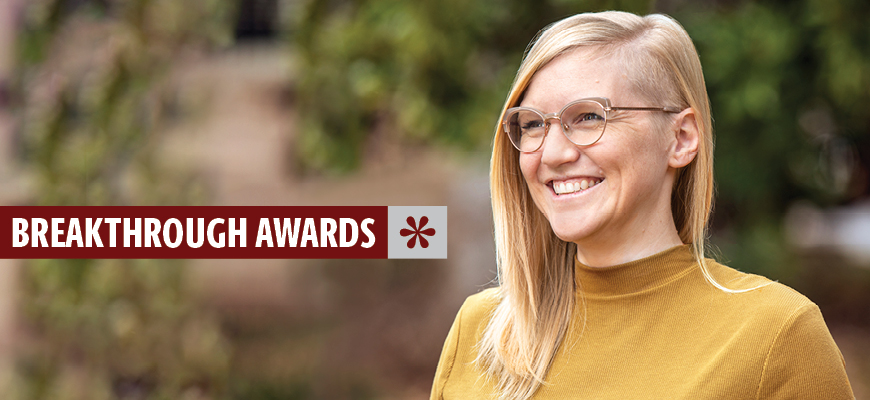
Breakthrough Star: Jessica Bradshaw
Psychology researcher looks for early signs of autism
Posted on: June 29, 2021; Updated on: June 29, 2021
By Chris Horn, [email protected], 803-777-3687
Researchers have learned a lot about autism spectrum disorder, and there are troves of research findings on infant development. Jessica Bradshaw is combining the two fields to better understand what autism looks like from birth through the first six months of life.
Autism, a condition related to brain development that affects social interaction and communication abilities, usually is diagnosed at age 2 or 3, but relatively little is known about infants’ neurobehavior.
Bradshaw, an assistant professor of psychology in the College of Arts and Sciences, has established the Early Social Development and Intervention Lab at the University of South Carolina, focused on identifying early markers of autism in infants.
“We think of autism as a congenital disorder, meaning we think infants are born with it. Yet we have not been able to identify differences in infants before six months, “ she says. “We do developmental and behavioral assessments that are aimed at tapping into the underlying neurological mechanisms that are driving those behaviors. I use these assessments to identify atypical trajectories of development that might predict a later diagnosis of autism.”
We know so much about brain development in the first months of life. If we know what’s different with autism, we can identify ways to modify (a child’s) environment.
Jessica Bradshaw
The ultimate goal of her work is to leverage technology to develop behavioral interventions that are both innovative and effective for children, even in the first year of their lives.
“We have behavioral interventions for toddlers and kids once they’re diagnosed with autism. I’m interested in interventions we might be able to implement before there is a language delay or before there are these big disparities in social communication and in social behavior,” Bradshaw says. “These are things that might help us tailor or modify or adapt parent-infant interaction to support social communication and social development. That’s the ultimate long-term goal.”
Bradshaw has been interested in autism research since her undergraduate days at the University of California San Diego when she was involved in autism interventions and worked in a research lab. She says she’s drawn to learning more about detecting autism in infants as a way to provide early support for the child and the family. The earlier autism intervention starts, the better the outcome.
While there isn’t a blood test or biomarkers to identify autism in infants, Bradshaw uses assessment tools such as how a heart rate changes when an infant is interacting with a parent or with objects. She recruits three groups of infants in her lab: those with no family history of autism; infants born pre-term who are at greater likelihood of developing autism; and those with an elevated genetic likelihood, meaning they have a sibling who has been diagnosed with autism. The children are studied through the first two years of their lives.
“We know so much about brain development in the first months of life. This is the time period when the brain is at its peak in plasticity. If we know what’s different with autism, we can identify ways to modify (a child’s) environment,” she says. “Perhaps we can mitigate some of the most challenging parts of autism that might emerge later in development.”
Share this Story! Let friends in your social network know what you are reading about